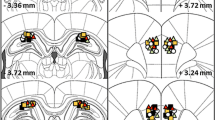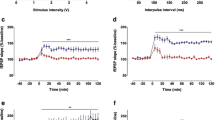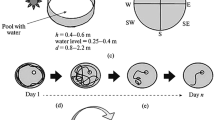Abstract
Rationale
Long-term potentiation (LTP) is considered to be a cellular substrate of learning and memory. Indeed, the involvement of LTP-like mechanisms in spatial learning has consistently been demonstrated in the Morris water maze test. We have previously shown that hippocampal LTP in Lewis rats was modulated by cocaine self-administration, although the performance of cocaine-self-administered rats in the Morris water maze was not altered.
Objective
Given that the ease of the task previously used could have masked any possible effects of the cocaine-induced LTP enhancement on spatial learning, a new and more difficult water maze task was devised to address this issue.
Materials and methods
Animals self-administered cocaine (1 mg/kg) or saline under a fixed ratio 1 schedule of reinforcement for 22 days. Spatial learning was assessed in a difficult water maze task (four sessions, two trials per session with a 90-min intertrial interval), and spatial memory was also evaluated 48 h after training (a 90-s test). Additionally, reversal learning and perseverance were also studied.
Results
There was a reduced latency in finding the hidden platform during training, as well as improved memory of the platform location in cocaine-self-administered rats with respect to animals that self-administered saline. No differences were observed in reversal learning or perseverance between groups.
Conclusions
Our data suggest that cocaine self-administration facilitates learning and memory in the water maze test only when animals are submitted to highly demanding tasks, involving working memory or consolidation-like processes during the intertrial interval.






Similar content being viewed by others
References
Badanich KA, Adler KJ, Kirstein CL (2006) Adolescents differ from adults in cocaine conditioned place preference and cocaine-induced dopamine in the nucleus accumbens septi. Eur J Pharmacol 550:95–106
Bashkatova V, Meunier J, Maurice T, Vanin A (2005) Memory impairments and oxidative stress in the hippocampus of in-utero cocaine-exposed rats. Neuroreport 16:1217–1221
Bashkatova V, Meunier J, Vanin A, Maurice T (2006) Nitric oxide and oxidative stress in the brain of rats exposed in utero to cocaine. Ann NY Acad Sci 1074:632–642
Bliss TV, Collingridge GL (1993) A synaptic model of memory: long-term potentiation in the hippocampus. Nature 361:31–39
Crespo JA, Manzanares J, Oliva JM, Corchero J, Palomo T, Ambrosio E (2001) Extinction of cocaine self-administration produces a differential time-related regulation of proenkephalin gene expression in rat brain. Neuropsychopharmacology 25:185–194
Crespo JA, Manzanares J, Oliva JM, Corchero J, Garcia-Lecumberri C, Ambrosio E (2003) Extinction of cocaine self-administration produces alterations in corticotropin releasing factor gene expression in the paraventricular nucleus of the hypothalamus. Brain Res Mol Brain Res 117:160–167
Dalley JW, Theobald DE, Berry D, Milstein JA, Laane K, Everitt BJ, Robbins TW (2005) Cognitive sequelae of intravenous amphetamine self-administration in rats: evidence for selective effects on attentional performance. Neuropsychopharmacology 30:525–537
Del Olmo N, Higuera-Matas A, Miguens M, Garcia-Lecumberri C, Borcel E, Solis JM, Ambrosio E (2006a) Hippocampal synaptic plasticity and water maze learning in cocaine self-administered rats. Ann NY Acad Sci 1074:427–437
del Olmo N, Miguens M, Higuera-Matas A, Torres I, Garcia-Lecumberri C, Solis JM, Ambrosio E (2006b) Enhancement of hippocampal long-term potentiation induced by cocaine self-administration is maintained during the extinction of this behavior. Brain Res 1116:120–126
Dudai Y (2004) The neurobiology of consolidations, or, how stable is the engram? Annu Rev Psychol 55:51–86
Dworkin SI, Co C, Smith JE (1995) Rat brain neurotransmitter turnover rates altered during withdrawal from chronic cocaine administration. Brain Res 682:116–126
Eichenbaum H, Otto T (1993) LTP and memory: can we enhance the connection. Trends Neurosci 16:163–164
Frantz KJ, O’Dell LE, Parsons LH (2007) Behavioral and neurochemical responses to cocaine in periadolescent and adult rats. Neuropsychopharmacology 32:625–637
French SJ, Totterdell S (2002) Hippocampal and prefrontal cortical inputs monosynaptically converge with individual projection neurons of the nucleus accumbens. J Comp Neurol 446:151–165
Fu Y, Pollandt S, Liu J, Krishnan B, Genzer K, Orozco-Cabal L, Gallagher JP, Shinnick-Gallagher P (2007) Long-term potentiation (LTP) in the central amygdala (CeA) is enhanced after prolonged withdrawal from chronic cocaine and requires CRF1 receptors. J Neurophysiol 97:937–941
Fuster JM (2001) The prefrontal cortex—an update: time is of the essence. Neuron 30:319–333
Gasbarri A, Packard MG, Campana E, Pacitti C (1994) Anterograde and retrograde tracing of projections from the ventral tegmental area to the hippocampal formation in the rat. Brain Res Bull 33:445–452
Huang CC, Lin HJ, Hsu KS (2007) Repeated cocaine administration promotes long-term potentiation induction in rat medial prefrontal cortex. Cereb Cortex (in press)
Jentsch JD, Olausson P, De La Garza R, Taylor JR (2002) Impairments of reversal learning and response perseveration after repeated, intermittent cocaine administrations to monkeys. Neuropsychopharmacol 26:183–190
Kantak KM, Udo T, Ugalde F, Luzzo C, Di Pietro N, Eichenbaum HB (2005) Influence of cocaine self-administration on learning related to prefrontal cortex or hippocampus functioning in rats. Psychopharmacology (Berl) 181:227–236
Kishi T, Tsumori T, Yokota S, Yasui Y (2006) Topographical projection from the hippocampal formation to the amygdala: a combined anterograde and retrograde tracing study in the rat. J Comp Neurol 496:349–368
Kuo YM, Liang KC, Chen HH, Cherng CG, Lee HT, Lin Y, Huang AM, Liao RM, Yu L (2007) Cocaine-but not methamphetamine-associated memory requires de novo protein synthesis. Neurobiol Learn Mem 87:93–100
Lynch MA (2004) Long-term potentiation and memory. Physiol Rev 84:87–136
Melnick SM, Kubie JL, Laungani R, Dow-Edwards DL (2001) Impairment of spatial learning following preweaning cocaine exposure in the adult rat. Neurotoxicol Teratol 23:445–51
Moser EI, Krobert KA, Moser MB, Morris RG (1998) Impaired spatial learning after saturation of long-term potentiation. Science 281:2038–2042
Quirk PL, Richards RW, Avery DD (2001) Subchronic cocaine produces training paradigm-dependent learning deficits in laboratory rats. Pharmacol Biochem Behav 68:545–553
Rebec GV (2006) Behavioral electrophysiology of psychostimulants. Neuropsychopharmacology 31:2341–2348
Richter-Levin G, Thomas KL, Hunt SP, Bliss TV (1998) Dissociation between genes activated in long-term potentiation and in spatial learning in the rat. Neurosci Lett 251:41–44
Ridley RM (1994) The psychology of perserverative and stereotyped behaviour. Prog Neurobiol 44:221–231
Roesch MR, Calu DJ, Burke KA, Schoenbaum G (2007) Should I stay or should I go? Transformation of time-discounted rewards in orbitofrontal cortex and associated brain circuits. Ann NY Acad Sci 1104:21–34
Santucci AC, Capodilupo S, Bernstein J, Gomez-Ramirez M, Milefsky R, Mitchell H (2004) Cocaine in adolescent rats produces residual memory impairments that are reversible with time. Neurotoxicol Teratol 26:651–661
Schmidt HD, Anderson SM, Famous KR, Kumaresan V, Pierce RC (2005) Anatomy and pharmacology of cocaine priming-induced reinstatement of drug seeking. Eur J Pharmacol 526:65–76
Schoenbaum G, Setlow B (2005) Cocaine makes actions insensitive to outcomes but not extinction: implications for altered orbitofrontal–amygdalar function. Cereb Cortex 15:1162–1169
Schoenbaum G, Saddoris MP, Ramus SJ, Shaham Y, Setlow B (2004) Cocaine-experienced rats exhibit learning deficits in a task sensitive to orbitofrontal cortex lesions. Eur J Neurosci 19:1997–2002
Smith DA, Browning M, Dunwiddie TV (1993) Cocaine inhibits hippocampal long-term potentiation. Brain Res 608:259–265
Terwilliger RZ, Beitner-Johnson D, Sevarino KA, Crain SM, Nestler EJ (1991) A general role for adaptations in G-proteins and the cyclic AMP system in mediating the chronic actions of morphine and cocaine on neuronal function. Brain Res 548:100–110
Thome J, Sakai N, Shin K, Steffen C, Zhang YJ, Impey S, Storm D, Duman RS (2000) cAMP response element-mediated gene transcription is upregulated by chronic antidepressant treatment. J Neurosci 20:4030–4036
Thompson AM, Gosnell BA, Wagner JJ (2002) Enhancement of long-term potentiation in the rat hippocampus following cocaine exposure. Neuropharmacology 42:1039–1042
Thompson AM, Swant J, Gosnell BA, Wagner JJ (2004) Modulation of long-term potentiation in the rat hippocampus following cocaine self-administration. Neuroscience 127:177–185
Udo T, Ugalde F, DiPietro N, Eichenbaum HB, Kantak KM (2004) Effects of persistent cocaine self-administration on amygdala-dependent and dorsal striatum-dependent learning in rats. Psychopharmacology (Berl) 174:237–245
Varvel SA, Lichtman AH (2002) Evaluation of CB1 receptor knockout mice in the Morris water maze. J Pharmacol Exp Ther 301:915–924
Wang GW, Cai JX (2006) Disconnection of the hippocampal–prefrontal cortical circuits impairs spatial working memory performance in rats. Behav Brain Res 175:329–336
Acknowledgements
The authors wish to thank Dr. C. Venero for helpful comments on the experimental design and R. Ferrado and A. Marcos for technical assistance. All the experiments were performed according to the European Union Laboratory Animal Care guidelines (86/609/ECC directive). The authors declare that they do not have financial interests to disclose. This research was supported by: the “Plan Nacional Sobre Drogas” 2001–2003 and 2004–2006, the “Instituto de Salud Carlos III—Red de Trastornos Adictivos” (G03/05), the “Ministerio de Educación y Ciencia” (BSO2001-1099, SAF2004-08148), and the “Plan de Promoción de la Investigación en la UNED” grants. Cocaine hydrochloride was kindly provided by the Dirección General de Estupefacientes, Spain.
Author information
Authors and Affiliations
Corresponding author
Additional information
Del Olmo and Higuera-Matas contributed equally to this work.
Rights and permissions
About this article
Cite this article
Del Olmo, N., Higuera-Matas, A., Miguéns, M. et al. Cocaine self-administration improves performance in a highly demanding water maze task. Psychopharmacology 195, 19–25 (2007). https://doi.org/10.1007/s00213-007-0873-1
Received:
Accepted:
Published:
Issue Date:
DOI: https://doi.org/10.1007/s00213-007-0873-1




